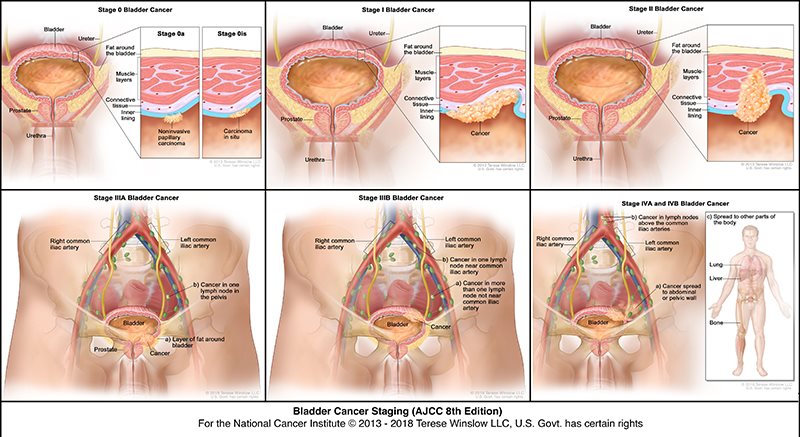The bladder's primary function is to store urine, the waste that is produced when the kidneys filter the blood. Urine passes from the two kidneys into the bladder through two tubes called ureters and urine leaves the bladder through another tube called the urethra. The bladder has a muscular wall that allows it to get larger and smaller as urine is stored or emptied.
The wall of the bladder is lined with several layers of cells called transitional cells. Cancer arising from these cells makes up more than 90% of all bladder cancers and these are referred to as transitional cell carcinomas. Because transitional cell carcinomas are the most common type of bladder cancer, the information in this section only addresses treatment of transitional cell cancer of the bladder.
Bladder cancer occurs predominantly in elderly men and less frequently in women and younger men. Many bladder cancers are thought to be caused by exposure to cancer-causing agents that pass through the urine and come into contact with the bladder lining.

Signs and Symptoms
The following may be symptoms of bladder cancer, but could be linked to other health conditions:- Blood in the urine; urine may appear orange, pink, or dark red in color
- Struggle to urinate, or weak urine stream
- Painful or burning urination
- Frequent urination or feeling the need to urinate without being able to produce
Risk Factors
- Age: The risk of developing bladder cancer increases with age. Almost nine out of 10 of those diagnosed are over the age of 55.
- Family History: People with a family history of bladder cancer are at greater risk of developing the disease. Certain inherited gene syndromes can also increase risk of bladder cancer.
- Personal History: Those who have had bladder cancer in the past are at an increased risk of recurrence.
- Gender: Men are three to four times more likely than women to develop bladder cancer.
- Tobacco: Risk of bladder cancer among smokers is approximately three times that of nonsmokers. About half of all bladder cancer cases are caused by smoking.
- Chemical Exposure: People who work with certain chemicals or in certain industries are at higher risk for developing bladder cancer. Industry examples include dye, leather, paint, printing, textiles, and rubber. Individuals with exposure to high levels of arsenic in their drinking water are also at a greater risk, as are those exposed to the chemo drug cyclophosphamide. Those who took the diabetes drug pioglitazone hydrochloride for more than a year may be at higher risk.
- Parasites: People infected with certain kinds of parasites face a higher risk.
Bladder Cancer Treatments
Lake Sumter Urology provide leading-edge bladder cancer treatment options, including surgery, radiation, chemotherapy and immunotherapy.Bladder cancer may be treated by different members of the cancer care team, including urologists, medical oncologists, and radiation oncologists. Treatment options vary depending on how advanced the cancer is and if it has spread to other parts of the body. Physicians will determine the most appropriate treatment for each patient, but in 90 percent of cases will perform surgery alone or in combination with other treatments.
Surgery
There are several different surgical procedures available to help diagnose and treat of the different stages of bladder cancer. These procedures range from a transurethral resection (TUR), or removal of a small portion of the bladder through a small tube called a cystoscope, to the complete surgical removal of the bladder (radical cystectomy) in advanced cases. Learn more.Radiation Therapy
Radiation therapy or radiotherapy uses high-energy rays to damage or kill cancer cells by preventing them from growing and dividing. Currently the use of radiation therapy alone as a primary bladder cancer treatment has largely been replaced by the combined use of radiation therapy and chemotherapy. The main use of radiation therapy is in combination with chemotherapy for treatment of patients with stage II-III or recurrent bladder cancer. However, radical cystectomy remains the primary modality for the treatment of stages II and III bladder cancer. Learn more.Chemotherapy
Over the past decade, many clinical trials in the United States and Europe have evaluated the combination of radiation and chemotherapy as initial treatment of stage II-III bladder cancer for the purpose of preserving the bladder. In some clinical trials, approximately half or more of patients who were treated with bladder-preserving therapy (initial TUR of as much cancer as possible, plus chemotherapy and radiation therapy) survived cancer-free three to four years after treatment. While bladder-preserving therapy has been widely adopted for the treatment of stage II-III bladder cancer, some physicians still think it should be limited to clinical trials and not adopted as standard therapy. Learn more.Stages
When bladder cancer is diagnosed, the urologist will want to learn the stage or extent of the cancer, as well as the grade (aggressiveness) of the cancer as determined by its appearance under the microscope. Grade is important because it indicates how closely the cancer resembles normal tissue and suggests how fast the cancer is likely to grow. Low-grade cancers more closely resemble normal tissue and are likely to grow and spread more slowly than high-grade cancers.Staging is an attempt to determine the extent to which the cancer has spread. The stage of bladder cancer may be determined at the time of diagnosis or it may be necessary to perform additional tests such as computerized tomography (CT) scans, magnetic resonance imaging (MRI) or an intravenous pyelogram (IVP), a procedure which involves the injection of dye into the blood. When the dye (contrast) travels through the kidneys and ureters, it allows them to be visualized with X-rays (fluoroscopy).
